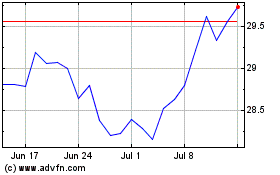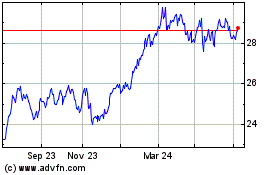BEIJING—Chinese trade started 2016 on a weak note as January
exports declined far more than expected in the face of weak demand
and slower production ahead of the just-ended Lunar New Year
holiday.
The General Administration of Customs reported Monday that
exports fell 11.2% year-over-year in January, following a drop of
1.4% in December. The January export figure was well below a median
forecast for a 2.4% decrease of 13 economists surveyed by The Wall
Street Journal. Imports last month declined 18.8%, compared with
December's 7.6% decline. That was also well below expectations for
a 4.6% decrease.
"It's definitely weaker than the market expected," said Standard
Chartered PLC economist Shuang Ding. "There's still no improvement
from the trade account."
Because imports declined even more than exports, China faced a
greater-than-expected $63.29 billion trade surplus in January—a
monthly record which followed December's $60.1 billion surplus.
The import drop came despite a sharp jump in imports from Hong
Kong that some economists suggest is largely due to companies
manipulating invoices to avoid China's restrictions on capital
leaving the country.
Economists warn that January and February data must be viewed
with caution as the floating Lunar New Year holiday tends to
greatly disrupt consumption and production patterns around
China.
The Shanghai Composite Index, which reopened Monday after the
weeklong holiday, was down 1.5% in early trading.
Economists said weak global demand continued to weigh on exports
in China and other Asian nations. South Korea, which serves many of
the same U.S. and European markets as does China, saw an 18.5%
year-over-year decline in its January exports, its biggest monthly
drop in several years. And a subindex of China's official
purchasing managers' index that tracks new export orders has been
in contraction for 16 consecutive months.
"We do not think underlying trade conditions are improving,"
said Citibank in a research note.
Chen Yangfan, a salesman with Chinatop Home Products
Manufacturing Co., which exports small appliances and kitchenware
to the U.S. and Europe, said business recently has been flat at
best. He said he hopes Beijing will improve tax rebates to help
exporters like his company, which is located in southern Guangdong
province, adding that a weaker yuan against the dollar may help
boost overseas demand later in the year.
"The outlook for the market and export sales is not ideal," Mr.
Chen said. "The economy isn't good and competition is pretty
fierce. Actually, the situation in most areas isn't very good at
all. I just hope things will improve after the Lunar New Year."
In an interview with Caixin Media Co. reported over the weekend,
Chinese central bank governor Zhou Xiaochuan said that Beijing has
no intention of engineering a large depreciation of the yuan to
boost exports. While some exporters were using trade flows to move
capital offshore, this would be transitory as companies will
eventually repatriate the proceeds to pay wages and meet other
obligations back in China, Mr. Zhou was quoted as saying.
Chinese factories often stockpile goods in January to meet
orders after they return to work, but this year they purchased
less, one reason imports fell sharply and a sign of further trade
weakness ahead, economists said.
January imports were also weighed down by falling commodity
prices, especially oil—which tend to make trade flows look smaller
when measured in dollar terms, even when volumes remain relatively
constant—and by weak demand.
"Import numbers are in line with the 'supply-side economics,'
with a focus to cut outdated overcapacity, and also imply that the
domestic investment should remain weak," said Commerzbank AG
economist Zhou Hao.
Economists said they would continue to look closely at imports
from Hong Kong following a sharp December jump in shipments to
China from the former British colony that they attribute to
so-called overinvoicing, or efforts by investors to circumvent
capital restrictions and move money out of the country.
Imports from Hong Kong stood at $1.65 billion in January, more
than double from a year earlier, according to data from the Chinese
customs bureau, while exports to Hong Kong were $22.74 billion in
January, down 2.6% year on year.
"Import channels could have been used for some financial
arbitrage activities," said ANZ Bank in a report.
Overinvoicing was also widely regarded to have distorted trade
data for a period about two years ago, though that time it was due
to companies trying to get capital into, rather than out of,
China.
Chinese consumers are only permitted to purchase $50,000 worth
of dollars each calendar year. But manipulated foreign trade deals
offer a way around tightening restrictions, say economists.
In an example of how this is done, a Chinese company might
import 100,000 widgets at $5 apiece from a Hong Kong partner or
subsidiary company, paying them $500,000. It then exports the same
widgets back to Hong Kong at $1 apiece, receiving $100,000 from the
Hong Kong entity. The goods are back where they started, but
$400,000 has now moved offshore.
Grace Zhu and Liyan Qi contributed to this article.
Write to Mark Magnier at mark.magnier@wsj.com
(END) Dow Jones Newswires
February 15, 2016 00:15 ET (05:15 GMT)
Copyright (c) 2016 Dow Jones & Company, Inc.
Australia And New Zealan... (ASX:ANZ)
Historical Stock Chart
From Mar 2024 to Apr 2024

Australia And New Zealan... (ASX:ANZ)
Historical Stock Chart
From Apr 2023 to Apr 2024
